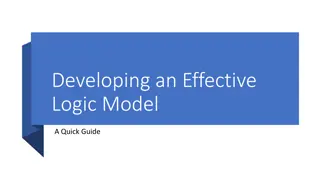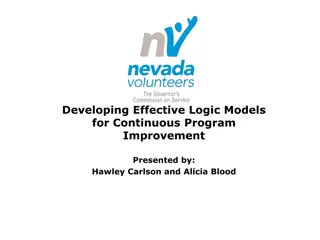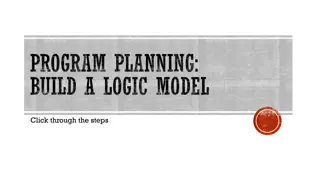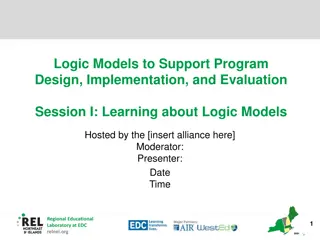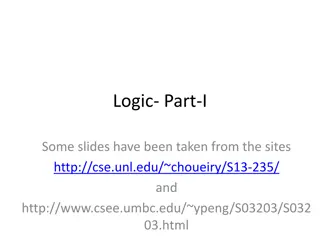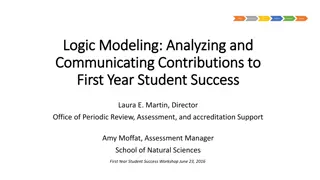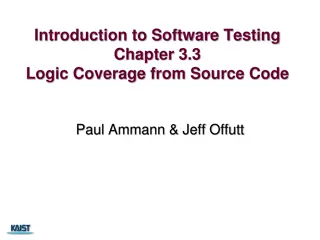Understanding Logic Modeling for Effective Program Development
Explore the fundamentals of logic modeling through "Picturing Your Program: An Introduction to Logic Modeling" by Yvonne Watson from the U.S. Environmental Protection Agency. Discover the purpose, components, and benefits of logic models in program planning, design, communication, implementation, and evaluation. Gain insights into depicting relationships between program activities and outcomes, identifying resources, and engaging stakeholders for successful program outcomes.
Download Presentation

Please find below an Image/Link to download the presentation.
The content on the website is provided AS IS for your information and personal use only. It may not be sold, licensed, or shared on other websites without obtaining consent from the author. Download presentation by click this link. If you encounter any issues during the download, it is possible that the publisher has removed the file from their server.
E N D
Presentation Transcript
Picturing Your Program: An Introduction To Logic Modeling Yvonne Watson U.S. Environmental Protection Agency
Agenda Welcome & Introductions Purpose of Today s Session Overview of Logic Models Logic Modeling Exercise Wrap Up 2
Why are we here? Introduce you to the basics of logic models what they are and how you can use them Provide you with a stepwise approach for developing a logic model 3
What is a logic model? A picture. Graphic and text that illustrates the relationship between a program s activities and its intended outcomes and results. So that these customers can change their ways To produce these outputs We use these resources Which leads to these outcomes Leading to these results! For these activities 5
The results we see What we have Who we reach/ influence WHY HOW What we produce/ deliver What we do Outcomes Resources/ Inputs: Outputs Activities Inter- mediate Customer Long- term Short-term Product or service delivery/ implementatio n targets you aim to produce. Things you do activities you plan to conduct in your program. Programmatic investments available to support the program. User of the products/ services. Target audience the program is designed to reach. Changes in learning, knowledge, attitude, skills, understanding Change in condition. Changes in behavior, practice or decisions. Attitudes Behavior Condition RESULTS FROM PROGRAM PROGRAM Assumptions External Influences The beliefs you have about the program, the people involved, the context and the way you think the program will work. Factors outside of your control (positive or negative) that may influence the outcome and impact of your program/project.
What are logic models used for? Planning tool Program design Communication tool Implementation tool Measurement design Evaluation design 7
What are the benefits of logic models? Illustrates the logic or theory of the program or project. Focuses attention on the most important connections between actions and results. Builds a common understanding among staff and with stakeholders. Establish a framework for measurement and evaluation and informs program design. Finds gaps in the logic of a program and works to resolve them. 8
What are the limitations of logic models? Represents reality; it is not reality Linear nature fails to reflect/capture the complexity of some programs Can over simplify a program Causal attribution is questionable does not prove the program caused the observed outcome Does not reflect unintended outcomes (positive or negative) 9
When can logic models be used? Work with grantees: Ensure grantee compliance and accurate reporting of activities, outputs and outcomes During staff and stakeholder orientation to: explain how the overall program works show how different people can work together define what each person is expected to do During planning to: clarify program strategy identify appropriate outcome targets (and avoid over-promising) negotiate roles and responsibilities During implementation to: provide an inventory of what you have and what you need to operate the program or initiative make mid-course adjustments During advocacy to: justify why the program will work explain how resource investments will be used Source: http://ctb.ku.edu/en/table-of-contents/overview/models-for-community-health-and-development/logic-model-development/main 10
How do you develop a logic model? 10 Clarify program goal and brainstorm/define the elements of the program. Step 1 Verify the logic table with stakeholders. Step 2 Develop a diagram and text describing logical relationships. Step 3 Verify the logic model with stakeholders. Step 4
Case Study: Tools for Schools (TfS) Launched in 1995 and managed by EPA Indoor Environments Division (IED) of the Office of Radiation and Indoor Air (ORIA). Voluntary outreach program provides schools with an IAQ Tools for Schools Action Kit, which provides guidance to school personnel on adopting proactive IAQ management practices to improve indoor air quality. 11
13 Step 1. Clarify the program goal and brainstorm/define the program elements Goal: Provide outreach, guidance & tools to assist school systems in reducing exposure to indoor contaminants by identifying, correcting and preventing indoor air quality (IAQ) problems (including asthma, allergy, and respiratory triggers) in the school environment. Resources Activities Outputs Customer reached Short-term Outcome Intermediate Outcome Long-term Outcomes 19 EPA FTE (HQ & Regions) Provide education/ outreach Trainings, symposia, conferences, walkthroughs State & Local health officials Increased awareness of IAQ & effective IAQ management practices from federal/state efforts Implementation/ institutionalization of IAQ policies & practices from federal & state efforts Decrease in asthma, allergy, & other IAQ symptoms Annual Budget State & local education officials Conduct program recruitment Grant funding TfS products School officials EPA Contractor support IAQ hotline reports Teachers & students Develop & distribute IAQ management products Development of IAQ management plan, policies & communications plan from federal & state efforts Articles, trade press, media tracking reports Facilities staff School nurses Raise public IAQ awareness Unions Community groups Architects & facility planners National Partners Conduct research Publications, case studies General public Management awards program Issue awards State and Local Partners External factors: Budget constraints, existing mandates, competing priorities, bond issues.
Step 2. Verify the logic table with stakeholders 14 Program Goal/Purpose: Provide outreach, guidance & tools to assist school systems in reducing exposure to indoor contaminants by identifying, correcting and preventing indoor air quality (IAQ) problems (including asthma, allergy, and respiratory triggers) in the school environment. If then If then If then If then If then If then Short-term Outcome: Increased awareness of IAQ & effective management practices Intermediate Outcome: Development & implementation of IAQ plan, policies & practices Customers: School officials, teachers & students, facilities staff, school nurses Long-term Outcome: Decrease in IAQ Triggers Decrease in Asthma Outputs: Training, symposium, conferences, walkthroughs Activities: Provide education/ outreach Resources: 19 EPA FTE (HQ & Regions)
Step 3. Develop a diagram and text describing logical relationships 15 Program Purpose: Provide outreach, guidance & tools to assist school systems in reducing exposure to indoor contaminants by identifying, correcting and preventing indoor air quality (IAQ) problems (including asthma, allergy, and respiratory triggers) in the school environment. Short-term Outcome: Increased awareness of IAQ & effective management practices Intermediate Outcome: Development & implementation of IAQ plan, policies & practices Long-term Outcome: Decrease in IAQ Triggers Decrease in Asthma Customers: School officials, teachers & students, facilities staff, school nurses Outputs: Training, symposium, conferences, walkthroughs Activities: Provide education/ outreach Resources: 19 EPA FTE (HQ & Regions)
Step 4. Verify the logic model with stakeholders 16 Key Questions to Consider Are the program s outcomes described? Are the program s customers described? Are the program s major resources, activities and outputs described and do they make sense? Are there things/issues that might influence the program s ability to achieve its goal?
INDOOR AIR QUALITY TOOLS FOR SCHOOLS (TfS) PROGRAM EPA -LEVEL LOGIC MODEL (CONTINUED) 18
Courtney and Bailey Peters Model: A Safe Place to Play Source: Community Tool Box: http://ctb.ku.edu/tools/sub_section_examples_1877.htm#example6 20
Lead A Great Life Program Areas Activities and processes Short-term goals (Impact Measures) Long-term goals (Outcome Measures) VACUUM AT LEAST ONCE A MONTH BY 2010 IMPROVED SELF-ESTEM (PSYCHOLOGICAL TEST) REDUCED # OF ASTHMA ATTACKS FROM DUST MITES FIND A PLACE TO PUT MY JUNK PERSONAL GO GROCERY SHOPPING WEEKLY DECREASED DISTRACTEDNESS (PSYCHOLOGICAL TEST) INCREASE # OF DAYS WHEN 5 FRUITS AND VEGETABLES ARE CONSUMED PLAN MEALS MAINTAIN A FOOD DIARY Lead a great life BRUSH AND FLOSS AFTER EVERY MEAL BY 2013 HAVE BIRTH CERTIFICATES FOR TWO CHILDREN BY 2010, INCREASE BY 200% THE NUMBER OF DATES PER YEAR INTER- PERSONAL USE OIL OF OLAY SKIN TREATMENTS IDENTIFY NEW WAYS TO MEET PEOPLE TAKE GUITAR LESSONS AND PRACTICE DAILY BY 2025 BECOME A FAMOUS ROCK STAR (WIN A GRAMMY) BY 2013, INCREASE BY 300% THE NUMBER OF FEATURED PERFORMANCES PER YEAR WRITE 2 NEW SONGS PER MONTH HOBBIES FORM A BAND 21
OW Area 1 Logic Model: Infrastructure (Exhibit 2-2) Source: Evaluation of National Water Program s Climate Change Adaptation Strategy, Final Report, July 22, 2013
Exercise Think about someone or something you want to change (Self, State Agency, Batting average for little league team, etc. ) 1. Why is this change important? To what outcome/results will it lead? 2. What aspect of the change do you have direct control over? What else has to happen to enable full realization of the change 3. Now, develop a logic model that will describe how you will achieve the desired change. 24
What next? Questions Wrap Up Building on your logic model Developing Performance Measures Evaluation Questions 25
Contacts Yvonne M. Watson watson.yvonne@epa.gov 202.566.2239 26
Appendix 27
Performance Management Tools Performance Management Performance management includes activities to ensure that goals are consistently being met in an effective and efficient manner. Performance management tools include logic models, performance measurement and program evaluation. Performance Measurement Program Evaluation Logic Model Helps you understand and explain why you re seeing the program/project results. Tool/framework that helps identify the program/project resources, activities, outputs customers, and outcomes. Helps you understand what level of performance is achieved by the program/project. 28
Measures Across the Logic Model Spectrum Element Definition Resources/ Inputs Example of Measures Measure of resources consumed by the organization. Amount of funds, # of FTE, materials, equipment, supplies (etc.). Measure of work performed that directly produces the core products and services. # of training classes offered as designed; Hours of technical assistance training for staff. Activities Measure of products and services provided as a direct result of program activities. # of technical assistance requests responded to; # of compliance workbooks developed/delivered. Outputs Measure of target population receiving outputs. % of target population trained; # of target population receiving technical assistance. Customer Reached Measure of satisfaction with outputs. % of customers dissatisfied with training; % of customers very satisfied with assistance received. Customer Satisfaction Accomplishment of program goals and objectives(short-term and intermediate outcomes, long-term outcomes--impacts). Outcomes % increase in industry s understanding of regulatory recycling exclusion; # of sectors that adopt regulatory recycling exclusion; % increase in materials recycled. 29
Work Quality Measures Definition Measure that relates outputs to costs. Category Efficiency Examples Cost per workbook produced; cost per inspection conducted. 30 Productivity Measure of the rate of production per some specific unit of resource (e.g., staff or employee). The focus is on labor productivity. Number of enforcement cases investigated per inspector. Cost Effectiveness Measure that relates outcomes to costs. Cost per pounds of pollutants reduced; cost per mile of beach cleaned. Service Quality Measure of the quality of products and services produced. Percent of technical assistance requests responded to within one week.
Evaluation and the Logic Model Design Evaluation 31 HOW WHY Longer term outcome (STRATEGIC AIM) Short term outcome Intermediate outcome Activities Outputs Customers Resources/ Inputs Impact Evaluation Outcome Evaluation Process Evaluation Source: Adapted from Evaluation Dialogue Between OMB and Federal Evaluation Leaders: Digging a Bit Deeper into Evaluation Science, April 2005
Common Evaluation Questions Evaluation Type Common Evaluation Questions Design Evaluation Is the design of the program well formulated, feasible, and likely to achieve the intended goals? Process/Implementation Evaluation Is the program being delivered as intended to the targeted recipients? Is the program well managed? What progress has been made in implementing new provisions? 32 Outcome Evaluation Are desired program outcomes obtained? What role, if any ,did the program play? What role, if any, did the context play? Did the program produce unintended outcomes? Impact Evaluation Did the program cause the desired impact? Is one approach more effective than another in obtaining the desired outcomes? Source: Adapted from Evaluation Dialogue Between OMB and Federal Evaluation Leaders: Digging a Bit Deeper into Evaluation Science, April 2005
General Assistance Program (GAP) Grant Program Logic Model Program Goal: The primary purpose of GAP is to help federally recognized tribes and intertribal consortia build the basic components of a tribal environmental program, which may include planning, developing, and establishing the administrative, technical, legal, enforcement, communication, and outreach infrastructure. Outcomes Long-term Resources Activities Outputs Customers Short-term Intermediate Tribal Executives Established capacity to plan, develop implement, & manage environmental programs Legal Capability Tribes develop legal & enforcement infrastructure $62.5 M Provide Funding to Tribes GAP Grants Inter-Tribal Consortia Executives Enforcement Capability Tribes demonstrate ability to perform monitoring & inspections to ensure compliance Increased understand ing of the process required for an environ- mental program Provide technical assistance to tribes Technical & media- specific training Tribal Environmental Employees funded by GAP Agency Technical expertise Compliance with federal statues and regulations & Sustainability of tribal environmental programs Technical Capability Tribes develop technical skills for environmental management 65 FTE AIEO, Regions, National Program Mangers Communications Capability Tribes demonstrate ability to communicate about environmental issues Improved environmental conditions in Indian Country Administrative capability Tribes establish ability & procedures for managing & accounting for program funds, personnel, training etc. Legend: Letter codes are used to connect elements of the logic model to the evaluation questions, as shown in Exhibit 1-3. 34
Tribal GAP Performance Measures Resources Activities Outputs Customer reached Short-term Outcome Intermediate Outcome Long-term Outcomes Established capacity to plan, develop, implement & manage environmental programs $62.5 M 65 FTE AIEO, Regions, National Program Managers Provide funding to Tribes GAP Grants Tribal Executives Increased understanding of the process required for an environmental program Legal capability Enforcement Capability Technical Capability Communications Capability Administrative Capability Technical & media-specific training Inter-Tribal Consortia Executives Logic Model Elements Provide technical assistance to Tribes Tribal Environmental employees funded by GAP Improved environmental conditions in Indian Country Self reported increase in knowledge and understanding about the necessary steps in developing a tribal environmental program Self-reported increase in skills needed to develop tribal environmental programs Self-reported change in awareness and commitment to environmental programs in tribes Total GAP funding per year Number and percent of Federally recognized Tribes that have received GAP funds between 1994 and 2004 Percentage of tribes that have received technical assistance and media specific training Total number of environmental employees supported with GAP funds # of GAP recipients that have developed tribal codes, standards or enforcement programs to control pollution Example Measures Turnover rate for Tribal environmental employees 35
General Assistance Program (GAP) Grant Program Logic Model Program Goal: The primary purpose of GAP is to help federally recognized tribes and intertribal consortia build the basic components of a tribal environmental program, which may include planning, developing, and establishing the administrative, technical, legal, enforcement, communication, and outreach infrastructure. Outcomes Long-term Resources Activities Outputs Customers Short-term Intermediate Tribal Executives Established capacity to plan, develop implement, & manage environmental programs Legal Capability Tribes develop legal & enforcement infrastructure $62.5 M Provide Funding to Tribes GAP Grants What indicators of tribal capacity exist? A F Inter-Tribal Consortia Executives Enforcement Capability Tribes demonstrate ability to perform monitoring & inspections to ensure compliance Is GAP being accessed by all federally recognized tribes? Increased understand ing of the process required for an environ- mental program Provide technical assistance to tribes Technical & media- specific training Tribal Environmental Employees funded by GAP Agency Technical expertise G Compliance with federal statues and regulations & Sustainability of tribal environmental programs Technical Capability Tribes develop technical skills for environmental management E H 65 FTE AIEO, Regions, National Program Mangers How does participation in GAP increase understanding of how to develop a tribal environmental program? Communications Capability Tribes demonstrate ability to communicate about environmental issues I Improved environmental conditions in Indian Country Administrative capability Tribes establish ability & procedures for managing & accounting for program funds, personnel, training etc. To what extent have tribes achieved environmental capacity as suggested by the presence of indicators? Legend: Letter codes are used to connect elements of the logic model to the evaluation questions, as shown in Exhibit 1-3. J 36








